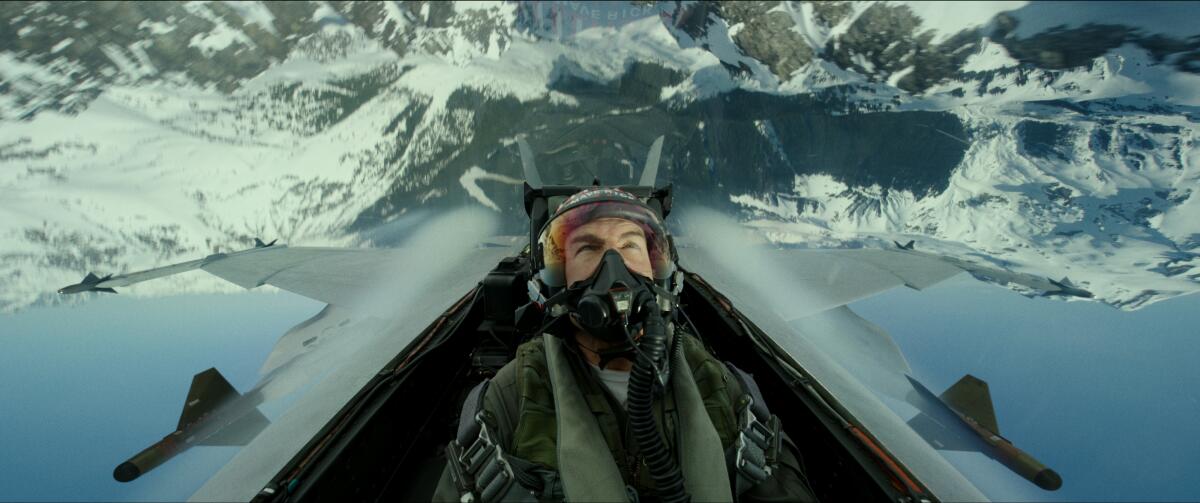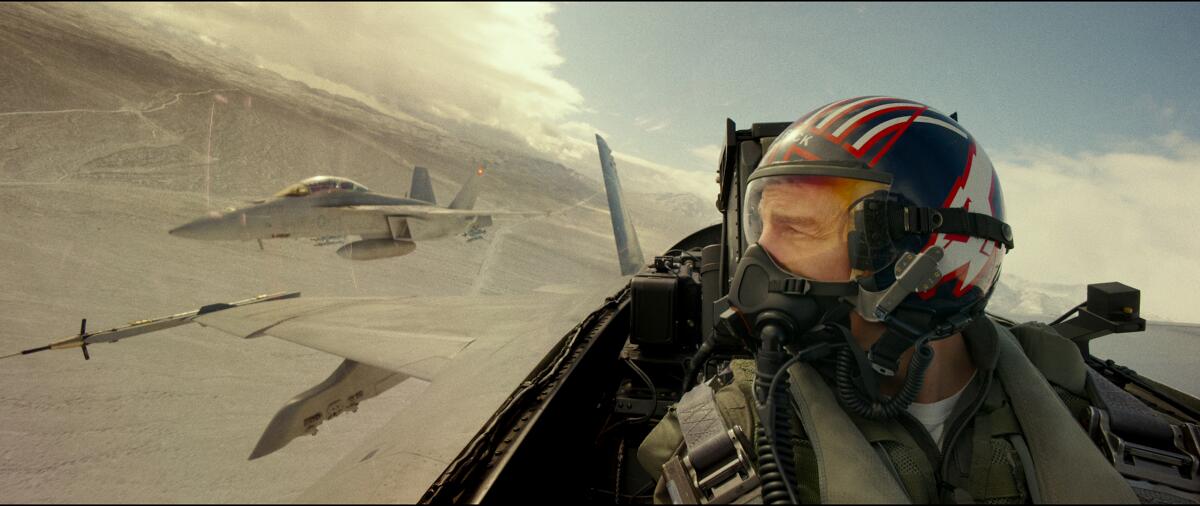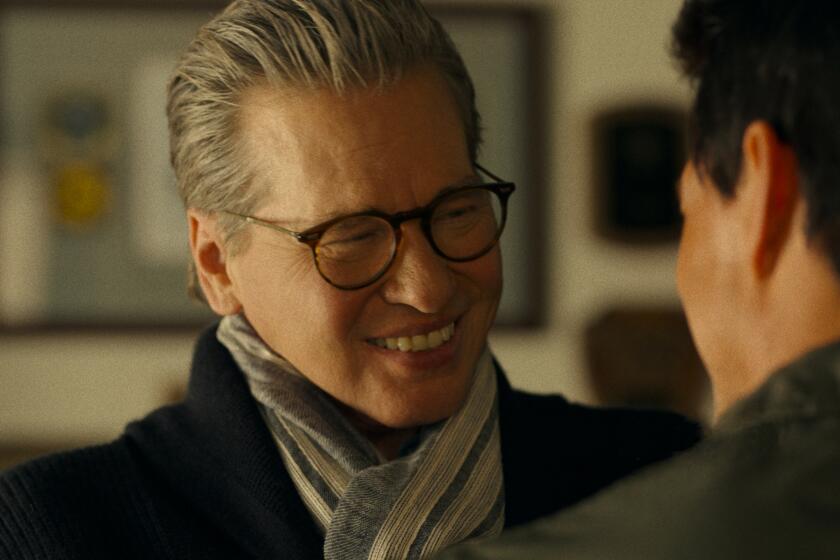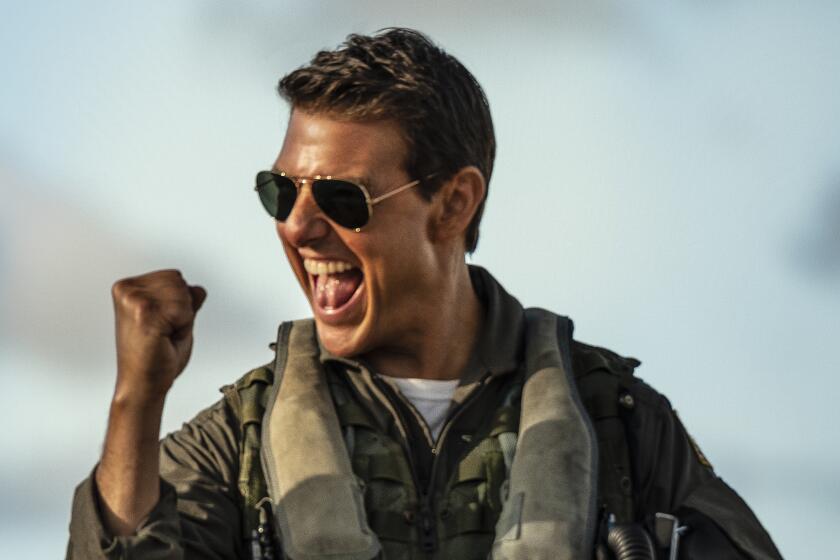How cinematography, editing fly ‘Top Gun: Maverick’ into the danger zone

- Share via
Cinematographer Claudio Miranda had an inkling “Top Gun: Maverick” might perform well at the box office opening weekend after he and director Joseph Kosinski boarded a plane and half the passengers were watching the film on their seat-back screens. “It was a real surreal moment,” says the “Life of Pi” Oscar winner, who’s collaborated with Kosinski on all of his features to date including the 2013 sci-fi thriller “Oblivion” that also starred Tom Cruise.
But before the popcorn was buttered and moviegoers felt the rush of being inside F-18 fighter jets, the hurdle for the creative team was the determination to photograph the sequel’s aerial work practically. “Our main theme was to be in-camera and to do something that hasn’t and may not be done again,” says Miranda.
It meant the actors would go through an extensive training program in order to sit inside a cockpit pulling over 7Gs of force. To capture the visceral high-flying affair, each jet was configured with six Imax-quality Sony Venice cameras with four facing the actor from different angles and two looking forward. Additional ground to air, helicopter to jet and jet to jet cameras intensified the action. Before every flight, extensive briefings were held determining the best route, angles and lighting, which Miranda backlit as much as possible.
Footage was then reviewed to make adjustments before going up again. Editor Eddie Hamilton made two valuable suggestions early on.
“Top Gun pilots are taught to fly fast and level because it’s efficient for fuel but it doesn’t make for interesting visuals because you just see a flat horizon. I said we should keep the horizon gently moving at all times because it will add more visual energy in these shots,” says Hamilton.
As ‘Top Gun: Maverick’ rules the summer box office, Val Kilmer opens up about its most talked-about scene.
His other idea came after filming an intense scene where one of the pilots (Coyote played by Greg Tarzan Davis) passes out during a training session. “He was very expressive with his eyes and slightly over the top in a dramatic way so you’re drawn into the emotion of the character. Tom [Cruise, who also served as producer] got all the actors in a room and we showed them that they needed to slightly exaggerate their head movements and what their eyes are doing. Because they’re covered with a mask, a lot of what they’re doing is acting with their eyes,” he says.
To push the cinematic envelope to new heights (and lows), Miranda found inspiration through the animated short “Paths of Hate.” “It has all this really super energetic [aerial] dogfighting with interesting angles that you can create in the animation world. I showed it to Tom and said how about we go with things that are almost impossible to shoot and try to do that,” says Miranda.

The mantra paid off, especially for the climactic mission “requiring nothing less than two consecutive miracles to be successful,” the first being a low-level flight through a canyon before inverting into a steep dive and taking out a small target using missiles. The second is a steep climb along a mountain as the pilots pull heavy amounts of G-force while trying to avoid enemy fire. The death-defying sequence is a result of careful planning and poring over every detail in the editing room. “Everything had to be perfect,” suggests Hamilton.
The aerial photography wasn’t the only material Miranda and Hamilton collaborated on to get just right. The entire story is shown through the perspective of Maverick with the Top Gun pilot appearing in nearly every scene. To connect the emotional beats of his journey to the audience, camera shots were designed to include Maverick in the foreground or background. An early bar scene that introduces his relationship with Penny (Jennifer Connelly) followed by the new recruits is a shining example.
He’s triumphed over spies, terrorists, aliens and Jack Nicholson; now Tom Cruise is swooping in to save the movie industry.
As the pilots make their way in, lower camera angles were used to present positions of power among the group, with Rooster (Miles Teller) being at the top of the pyramid. The introductory scene hinges around Maverick with subtle panning shots that attach him to the growing party that eventually has Rooster singing “Great Balls of Fire.” “We didn’t necessarily get it right the first time around,” says Hamilton. “When we felt we hadn’t quite captured the correct coverage or angles to really root the audience with Maverick as a character, we went back in and took another stab at it.”
Other scenes where they were able to explore the emotional tone further through additional coverage were the beach football scene where the pilots bond; when Maverick tells Penny, while in bed together, why he held Rooster back from pilot training, and the touching conversation between Maverick and Iceman (Val Kilmer).
“One of the reasons why big-budget movies can work is because you have the resources to go back and do pick-ups to make sure everything lands perfectly,” says Hamilton. “We are well aware of what a luxury that is but the resonance it can create with the audience is massive.”
More to Read
From the Oscars to the Emmys.
Get the Envelope newsletter for exclusive awards season coverage, behind-the-scenes stories from the Envelope podcast and columnist Glenn Whipp’s must-read analysis.
You may occasionally receive promotional content from the Los Angeles Times.












